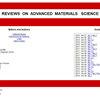熔融沉积建模用3D打印聚乳酸的共混及功能化改性
IF 3.6
4区 材料科学
Q2 MATERIALS SCIENCE, MULTIDISCIPLINARY
引用次数: 0
摘要
摘要聚乳酸(PLA)由于其资源丰富、生产工艺简单、可生物降解性好、机械强度好等优点,被广泛用于基于熔融沉积建模(FDM)的三维打印(3DP)。但它具有韧性差、弯曲变形直接等缺点。鉴于PLA材料在基于FDM的3d打印技术中的巨大应用潜力,本文总结了过去5年来在增强PLA用于FDM的特性方面所进行的研究。特别是,改性方法(化学或物理方法)已被用来改善PLA的机械和加工属性进行了讨论,随着PLA复合材料的发展具有独特的功能。本文提供的见解可以帮助扩大PLA复合材料在基于fdm的3d打印中的应用范围,用于交通运输、航空航天工程、工业设备制造、消费/电子产品制造和生物医学/医学等领域。本文章由计算机程序翻译,如有差异,请以英文原文为准。
Blending and functionalisation modification of 3D printed polylactic acid for fused deposition modeling
Abstract Polylactic acid (PLA) is extensively used as a raw material in fused deposition modeling (FDM)-based three-dimensional printing (3DP), owing to its abundant resources, simple production processes, decent biodegradability, and adequate mechanical strength. However, it has disadvantages such as poor toughness and straightforward bending deformation. Given the considerable application potential of PLA materials in FDM-based 3DP technology, herein, studies conducted over the last 5 years toward the enhancement of the characteristics of PLA for FDM are summarized. In particular, modification approaches (chemical or physical methods) that have been employed to improve the mechanical and processing attributes of PLA are discussed, along with the development of PLA composites with unique functionalities. The insights provided herein can help expand the scope of application of PLA composites in FDM-based 3DP for utilization in fields such as transportation, aerospace engineering, industrial equipment fabrication, consumer/electronic product manufacturing, and biomedicine/medicine.
求助全文
通过发布文献求助,成功后即可免费获取论文全文。
去求助
来源期刊

Reviews on Advanced Materials Science
工程技术-材料科学:综合
CiteScore
5.10
自引率
11.10%
发文量
43
审稿时长
3.5 months
期刊介绍:
Reviews on Advanced Materials Science is a fully peer-reviewed, open access, electronic journal that publishes significant, original and relevant works in the area of theoretical and experimental studies of advanced materials. The journal provides the readers with free, instant, and permanent access to all content worldwide; and the authors with extensive promotion of published articles, long-time preservation, language-correction services, no space constraints and immediate publication.
Reviews on Advanced Materials Science is listed inter alia by Clarivate Analytics (formerly Thomson Reuters) - Current Contents/Physical, Chemical, and Earth Sciences (CC/PC&ES), JCR and SCIE. Our standard policy requires each paper to be reviewed by at least two Referees and the peer-review process is single-blind.
 求助内容:
求助内容: 应助结果提醒方式:
应助结果提醒方式:


